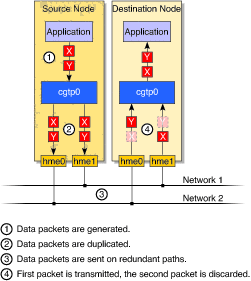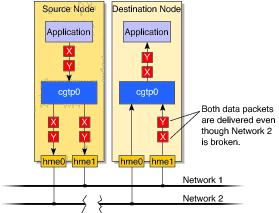| Netra™ High Availability Suite 3.0 1/08 Foundation Services Overview |
| C H A P T E R 3 |
The reliable network communication service is provided with the implementation of a reliable IP transport mechanism in each node. For information about the reliable IP transport mechanism provided by the Carrier Grade Transport Protocol (CGTP), see the following sections:
The Netra High Availability (HA) Suite software Foundation Services use a reliable IP transport mechanism provided by CGTP. CGTP is based on transparent multirouting using redundant routes.
In the Foundation Services, each peer node is connected by two high-speed Ethernet networks. When data is sent from a source node to a destination node, it is sent along both Ethernet networks. If data on one network fails to reach the destination node, the data on the other network is still able to reach the destination node. To ensure symmetry in the redundant routes, the Ethernet networks must have equal bandwidth and latency. To prevent single points of failure, the Ethernet networks must not share switching equipment or communication links.
CGTP is configured by the Cluster Membership Manager on peer nodes. CGTP installed on nonpeer nodes is called standalone CGTP. Standalone CGTP must be configured manually. For information about installing and configuring CGTP on nonpeer nodes, see the Netra High Availability Suite 3.0 1/08 Foundation Services Standalone CGTP Guide.
You can configure your cluster without CGTP. When CGTP is not used, each peer node is connected by one Ethernet network only. This configuration introduces a single point of failure. If the Ethernet network fails, there is no backup network.
This section describes how CGTP transfers data from a source node to a destination node.
CGTP adds a CGTP source address and CGTP destination address to the header of a data packet on a source node, creating an IP data packet. The header contains all the information necessary to uniquely identify an IP data packet.
The Cluster Membership Manager defines routing tables on the source node and destination node. CGTP duplicates the IP data packet, and, using the routing tables, sends one copy of each IP data packet on each of the Ethernet networks. FIGURE 3-1 illustrates the transfer of data packets from a source node to a destination node, using CGTP.

When the first IP data packet reaches its destination address, CGTP consults the filtering table on the destination node. CGTP verifies that the destination node has not already received the IP data packet. If it has not, CGTP sends the IP data packet to the higher protocols for processing. When the second incoming packet is detected, CGTP identifies it as a duplicate and filters it out. CGTP supports packet filtering on IPv4 and IPv6.
FIGURE 3-2 illustrates how CGTP is able to deliver the data packets when one of the redundant networks fails.

If one link fails, the data packet sent on the other network path can still reach the destination address. However, until Network 2 is repaired, the system is not HA.
On the Solaris OS, CGTP and IPMP can share physical links only when CGTP is used over a virtual local area network (VLAN). This requires a specific topology. For more information, refer to the Netra High Availability Suite 3.0 1/08 Foundation Services Manual Installation Guide for the Solaris OS.
On the Linux OS, CGTP cannot share interfaces with a Linux bonding driver, therefore, the available solutions are as follows:
Two interfaces for CGTP with two or more interfaces for bonding
Two interfaces for CGTP and the floating addresses on them without bonding
Note - This functionality is specific to the Solaris OS and is not supported on Linux. |
Copyright © 2008, Sun Microsystems, Inc. All rights reserved.